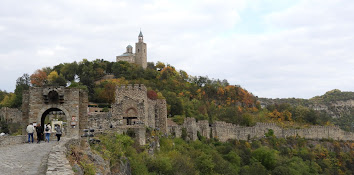Tsarevets Fortress, Veliko Tarnovo, Bulgaris
We crossed into Bulgaria several days ago with quite a bit
of confusion about how to actually get across the border. There were hundreds of trucks parked on each
side of the border, waiting to cross.
This is what the EU was supposed to eliminate, the endless delays that
are so costly to trade and the free flow of goods. But, Romania and Bulgaria are not part of the
Schengen Agreement which allows people and goods to move easily across borders,
so there are taxes to pay, documents to process and lots of time to wait in
line. We made it through in about 45
minutes, but could have sailed through much faster if we'd known where to go and what to do.
 |
| Lady and goat at Tsarevets Fortress |
 |
| Lady and goat at Tsarevets Fortress |
Bulgarians, like so many Central and Eastern Europeans, have spread out over Europe since joining the EU. Bulgarians drive a large percentage of the trucks that crisscross Europe. I read that the UK, after Brexit, is short 100,000 truck drivers now that Bulgarians and others can’t move there freely. Our guides have told us that their lives are noticeably better since Bulgaria joined the EU. You can see it in the motorways, built with EU money, the restored public buildings, the businesses that have opened offices here and the new jobs all this has created.
 |
| roses for rose oil--and beauty |
Our first stop was at the isolated Sveshtari Thracian Tombs
about 2 hours southeast of the border.
We were the only visitors today.
The only tomb that is open is small with beautifully carved stone
figures of women, presumably dancing or maybe worshipping. No photos are allowed, sadly, but these are
exquisite, though probably representative of women who didn’t want to be
there. These are ancient Greek tombs,
from the 3rd century BC. They
are found all over north central Bulgaria, in large mounds of earth, but most
have been robbed over the centuries. Here is the UNESCO website showing you some of the lovely figures at Sveshtari, a UNESCO World Heritage Site: https://whc.unesco.org/en/list/359/.
 |
| Ethnographic Museum in Ottoman house, Plovdiv |
We ended the day in Veliko Tarnovo to visit the fortress which was the capitol of Bulgaria for 400 years from the mid 12th century to the 16th century when the Turks finally annihilated the city. The fortress has huge walls and contained over 400 houses, at least one large palace, 23 churches and several monasteries. The Bulgarian government has been rebuilding the fortress, very poorly, but the site is wonderful to explore on foot. You can wander around the walls and through the remains of the village that thrived here for so long.
We came upon a small herd of goats cropping the grass. Later, their owner came to call them home and
they all trotted rapidly after her. One
goat did not cooperate, so she grabbed him by the horns and dragged him off to
wherever he was supposed to go.
 |
| Roman theater, Plovdiv |
After a night in the old Bulgarian capital of Veliko Tarnovo, we drove south the ancient city of Plovdiv. It’s the oldest continuously occupied city in Europe, first inhabited 8000 years ago, and has a charming, cobblestoned, hilly section that is the oldest part of the city, with Greek, Roman and Byzantine fortifications on top of the hill. In decay a decade ago, the city and private owners are restoring the buildings from the Ottoman era that ramble up the steep hillside. We particularly enjoyed the Ethnographic Museum, located in one of the large merchant houses from Ottoman days.
 |
| Turkish house, restored |
Plovdiv has lots of activity in the center of its old city, with thousands of people gathering there in bars and restaurants and shopping on their long pedestrian mall. It’s also the second largest city in Bulgaria, after Sofia, the capital, and is heavily industrialized. But, the center of the city lies atop Roman ruins, including a very long Roman stadium and 2 Roman theaters, parts of which you can see today. Two mosques serve the 10% of the population that is Muslim.
 |
| model of Roman stadium under Plovdiv |
On the way to Plovdiv, we drove through the Rose Valley, filled with greenhouses growing roses and lavender, and stopped to visit the Rose Museum. Instead of shipping fresh roses all over the world for Valentine’s Day and couple’s anniversaries, Bulgaria has been one of the leading exporters of rose oil for nearly 200 years. The family that first grew roses for their oil had offices in Istanbul, where the Ottoman Sultan greatly valued this essence, London and, later, New York. Young women used to harvest the roses and pluck off the petals to make the oil. The distillation process takes 2 steps, first soaking the petals in water and distilling the water and then separating the oil from the water. Both rose oil (very expensive) and rose water continue to be sold around the world.


No comments:
Post a Comment